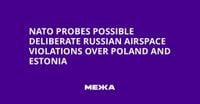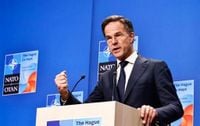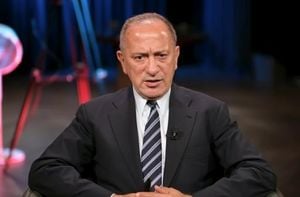In the early hours of September 2025, tensions along NATO’s eastern flank reached a fever pitch as Russian military aircraft and drones repeatedly breached the airspace of Poland and Estonia, sparking a flurry of diplomatic activity, military readiness, and international scrutiny. NATO Secretary General Mark Rutte, front and center at the Alliance’s Brussels headquarters, addressed the incidents with a measured but unmistakable gravity: NATO, he said, is still investigating whether Russia’s actions were deliberate or merely reckless. Either way, he insisted, "it is reckless and unacceptable."
These words, echoed by major outlets including Censor.NET and the European External Action Service, came against a backdrop of escalating aerial provocations. On the night of September 10, 2025, Polish airspace was pierced by a swarm of nineteen Russian drones. Four were shot down, but not before one damaged a house and a car in the Lublin Voivodeship. Debris rained down on several villages, forcing the temporary closure of four airports, including Warsaw’s main hub, Chopin. Polish Prime Minister Donald Tusk did not mince words: "This situation brings us the closest we have been to open conflict since World War Two."
For the first time since Moscow’s full-scale invasion of Ukraine in 2022, Russian drones were brought down over NATO territory. The Polish government responded swiftly, invoking Article 4 of the NATO treaty and launching urgent consultations among the 32-member alliance. Tusk emphasized the gravity of the situation in parliament, stating that "a line has been crossed, and it's incomparably more dangerous than before." Yet, he also reassured lawmakers and the public that there were no reports of injuries or deaths as a result of the Russian action.
The Kremlin, for its part, was quick to deflect. Russia’s Defence Ministry claimed there had been "no plans" to target Polish facilities, arguing that the drones’ range did not allow for deliberate incursions. Belarus, a close Russian ally, suggested the drones may have entered Polish airspace accidentally after their navigation systems were jammed. Meanwhile, Russia’s temporary charge d’affaires in Poland demanded evidence that the drones were indeed Russian.
But the pattern of incidents did not end with Poland. On September 19, three Russian MiG-31 fighter jets brazenly entered Estonian airspace for twelve minutes. Italian Air Force F-35s, stationed in Emari as part of NATO’s Baltic Air Policing mission, scrambled to intercept and escort the Russian planes out. Estonia’s Foreign Minister Margus Tsahkna was unequivocal: it was "a violation of territorial integrity and the principles of the UN Charter that obligate us to refrain from threats or use of force." That same day, two more Russian fighters were spotted over the Petrobaltic oil and gas platform in Polish territorial waters, a further sign of Moscow’s willingness to test NATO’s resolve.
In response, NATO’s leadership moved to bolster its eastern defenses. On September 12, just days after the drone incident, Secretary General Rutte launched the “Eastern Watch” operation. The mission aims to neutralize specific threats related to drone warfare and to strengthen coordination in Poland and Romania. By September 14, Polish President Karol Nawrocki had signed off on the continued presence of NATO troops on Polish and Romanian soil as part of this effort. In Romania, the situation was equally tense: on September 13, an air alert was declared in the country’s north, and two F-16s intercepted a Russian drone over the Danube. The Romanian Ministry of Defense clarified that the drone did not cross populated areas and posed no direct threat to civilians, but the message was clear—NATO would not stand idly by.
As these events unfolded, Ukrainian President Volodymyr Zelensky warned that the latest attacks set "an extremely dangerous precedent for Europe." Ukrainian Foreign Minister Andrii Sybiha accused Russian President Vladimir Putin of escalating and expanding the war. The United States, too, took notice; former President Donald Trump posted on Truth Social, "What's with Russia violating Poland's airspace with drones? Here we go!"
Within Poland, the military and civil response was robust. The Polish Ministry of Defense told the BBC that the drones "which could have posed a threat, were shot down pre-emptively." Polish and NATO aircraft—including F-35s, F-16s, and various helicopters—were dispatched to intercept the incursive drones. Ground-based air defense and radar systems were placed on maximum alert. The Polish military expressed gratitude to NATO’s Air Command and the Netherlands for deploying F-35 fighter jets, underscoring the Alliance’s commitment to collective defense.
Despite the unity among NATO members, not all voices were in agreement. Dmitry Peskov, press secretary to Russian President Vladimir Putin, flatly denied any Russian violation of NATO airspace. "All Russian military flights comply with international rules," he insisted, calling Western accusations "irresponsible." Peskov also took the opportunity to criticize Ukrainian President Zelensky, claiming Kyiv was more interested in war than peace, and boasted about Russia’s economic stability.
The diplomatic and military standoff has revived memories of past confrontations. Lithuania, recalling the 2015 incident when a Russian Su-25 was shot down after crossing Turkish airspace, suggested that NATO should be prepared to shoot down intruding aircraft. Polish Prime Minister Tusk echoed this sentiment, declaring that his country was ready to destroy any hostile objects entering its airspace. The British Ministry of Defense voiced similar readiness.
On the ground, the mood is one of cautious determination. Miroslaw Kaznowski, deputy mayor of Milanówek near Warsaw, praised the authorities’ response but stressed the need for greater preparedness, especially in smaller towns. "We need to be prepared. This has all now gone higher on the agenda," he told the BBC, noting that his town was building a new fire station to serve as a crisis management center.
As of September 30, 2025, NATO’s investigation into whether Russia’s actions were deliberate or accidental continues. While the motives remain unclear, the incidents have already prompted a tightening of NATO’s defensive posture and a renewed sense of unity among its members. The Alliance’s message, as articulated by Secretary General Rutte, is resolute: whether intentional or not, such violations are reckless and unacceptable.
In a region where history is never far from the present, the events of September 2025 have redrawn the lines of security and trust. The coming weeks will reveal whether this latest round of provocations marks a new phase in East-West tensions—or a turning point toward renewed dialogue and deterrence.







